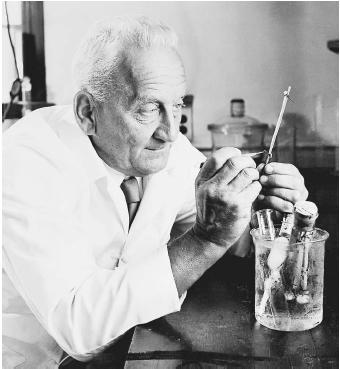Albert Szent-Györgyi
HUNGARIAN-BORN AMERICAN BIOCHEMIST
1893–1986
Albert Szent-Györgyi was surely one of the most important scientists of the twentieth century. His research interests included vitamins , enzymatic oxidation mechanisms, muscle contraction, and cancer. He won the 1937 Nobel Prize in physiology or medicine for his discovery of vitamin C and for his studies on the Krebs, or citric acid, cycle.
Szent-Györgyi was born in Budapest, Hungary, on September 16, 1893. His father, Nicholas von Szent-Györgyi, was a prominent landowner. His mother, Josefine Lenhossek, belonged to a highly educated family: Her father and brother were both professors of anatomy at the University of Budapest.
Szent-Györgyi entered the University of Budapest in 1911. He stayed there until the outbreak of World War I, at which time he was drafted into the Hungarian army. Subsequently he served on the Italian and Russian fronts. After being wounded in action, Szent-Györgyi received a medal for bravery and was discharged. He completed his studies in Budapest and during the next decade worked at some of the world's leading academic research centers, including the University of Groningen, Cambridge University, and the Mayo Clinic.
In 1930 Szent-Györgyi returned to Hungary as a professor of medicinal chemistry. He joined the anti-Nazi resistance movement in Hungary during World War II and was for a while exposed to constant danger. He left Hungary in 1947 to join the staff of the Marine Biological Laboratory at Woods Hole, Massachusetts.
During his stay at Groningen, Szent-Györgyi identified a compound present in plant and animal tissues that blocked the enzyme-catalyzed oxidation of fruits and vegetables (the browning of a sliced apple exposed to air is the result of an enzyme-catalyzed oxidation). At Cambridge, he continued his work on this reducing substance and managed to isolate minute

quantities of it from adrenal glands. Upon his return to Hungary, he discovered that the reducing substance cured scurvy.
The discovery prompted Szent-Györgyi to search for a more abundant and reliable source of the compound, and eventually he was able to isolate kilograms of it from paprika (the dried, ground fruit of the pepper plant capsicum annuum ). He named the new compound ascorbic acid, which means the acid that cures or prevents scurvy. (It also goes by the name of vitamin C.) Turkish invaders introduced paprika into Hungary in the sixteenth century and, historically, Hungary has been one of the world's leading exporters of paprika. Presumably large quantities of it were available to Szent-Györgyi, explaining why he looked to paprika to solve his supply problem.
Wanting to know the chemical structure of ascorbic acid, Szent-Györgyi gave a sample to Walter Haworth, a chemistry professor at the University of Birmingham in England and an expert in carbohydrate (sugar) chemistry. Haworth determined the complete chemical structure of ascorbic acid and shared the 1937 Nobel Prize in chemistry for his work.
An originator of many interesting and thought-provoking ideas, Szent-Györgyi died at Woods Hole on October 22, 1986.
SEE ALSO Ascorbic Acid .
Thomas M. Zydowsky
Bibliography
James, Laylin K., ed. (1993). Nobel Laureates in Chemistry 1901–1992. Washington, DC: American Chemical Society; Chemical Heritage Foundation.
Internet Resources
Bunce, Nigel, and Hunt, Jim. "Albert Szent-Györgyi and Vitamin C." Available from http://www.helios.physics.uoguelph.ca .
The Nobel Foundation. "The Nobel Prize in Physiology or Medicine 1937." Nobel e-Museum. Available from http://www.nobel.se/chemistry/laureates .
Comment about this article, ask questions, or add new information about this topic: